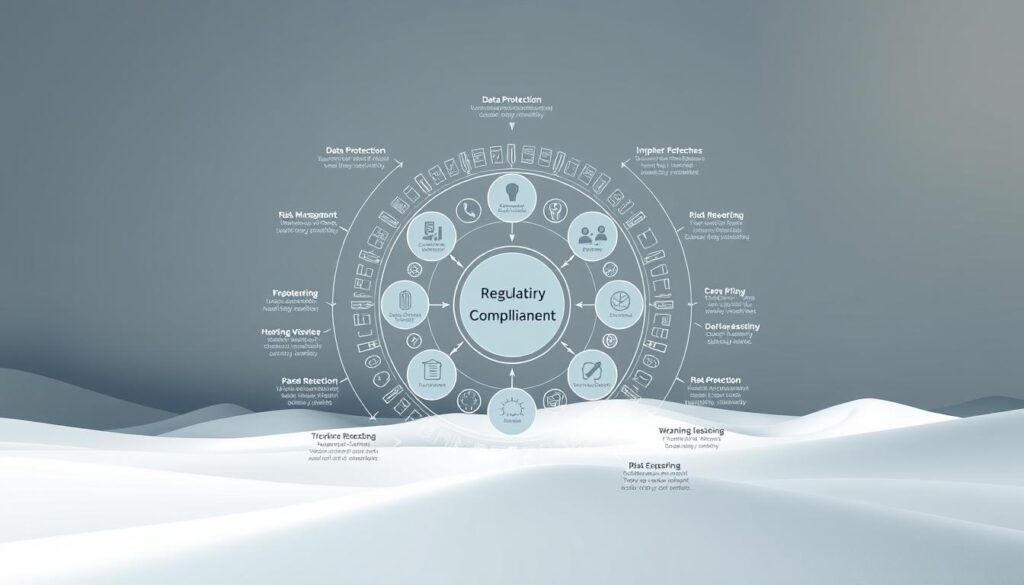Now Reading: Understanding Artificial intelligence crypto wallet security Measures
- 01
Understanding Artificial intelligence crypto wallet security Measures
Understanding Artificial intelligence crypto wallet security Measures

The digital asset landscape is transforming rapidly, with innovative technologies reshaping how we protect our investments. As more people embrace blockchain-based assets, the need for advanced protection methods becomes increasingly critical.
Recent industry data reveals explosive growth in fintech innovation. The market for smart technology solutions is projected to reach $43 billion by 2029, growing at nearly 24% annually. This surge reflects rising trust in blockchain systems and demand for sophisticated asset protection.
Traditional storage methods face significant challenges, with billions lost to digital theft annually. The convergence of cutting-edge computational systems and digital currency storage creates powerful new defenses against emerging threats.
This guide explores how modern computational systems are revolutionizing digital asset protection. Readers will discover fundamental changes in how storage solutions safeguard investments through predictive analytics and automated threat detection.
Key Takeaways
- Digital asset protection is evolving with advanced computational technologies
- The fintech innovation market shows massive growth potential through 2029
- Traditional storage methods face significant security challenges
- Predictive analytics and automation are transforming threat detection
- User expectations for both protection and seamless experience are rising
- Industry transformation signals the need for intelligent security solutions
Introduction to AI-Enhanced Crypto Wallets
A new generation of financial tools is emerging that actively learns from user behavior to provide personalized protection and optimization. These advanced systems represent a fundamental shift from basic storage containers to intelligent financial assistants.
Unlike traditional solutions that simply hold private keys, modern platforms analyze patterns and predict potential risks. They adapt to individual habits and market conditions in real-time. This proactive approach transforms how people interact with their digital assets.
The integration of machine learning algorithms enables these tools to function as personal financial companions. They understand preferences and continuously improve through interactions. Users benefit from automated management that balances protection with convenience.
These innovative platforms address critical challenges in digital finance. Complex interfaces become simplified through natural language processing. Constant market monitoring is handled automatically, freeing users from 24/7 vigilance.
For those seeking comprehensive protection, exploring advanced financial tools reveals how technology creates smarter, safer experiences. The evolution from passive storage to active partnership marks a significant advancement in digital asset management.
The Evolution of Crypto Wallets and AI Integration
Storage solutions for digital currencies have traveled an incredible path from simple key holders to sophisticated financial partners. This transformation reflects broader changes in how people manage their digital investments.
The journey began in 2009 with basic software programs. These early tools focused primarily on storing cryptographic keys and handling simple transactions.
From Basic Storage to Intelligent Solutions
As digital currency adoption grew, user demands pushed developers toward more advanced features. Multi-signature authentication and support for multiple blockchain networks became standard offerings.
The shift toward intelligent solutions accelerated as threats became more sophisticated. Modern platforms now offer comprehensive financial services beyond basic storage functions.
Milestones in Security Enhancements
Key developments include hardware options for cold storage and biometric authentication systems. These innovations addressed critical vulnerabilities in earlier generations.
Multi-party computation technology represents another significant advancement. This approach eliminates single points of failure while maintaining user convenience.
Contemporary systems combine traditional cryptographic methods with machine learning capabilities. This integration creates adaptive protection that responds to emerging threats in real time.
Understanding Artificial Intelligence Crypto Wallet Security
Today’s protective measures for digital holdings function more like intelligent partners than static tools. These systems employ advanced algorithms that study individual behavior patterns and transaction histories. They create personalized protection models that adapt to each person’s unique digital footprint.
Machine learning capabilities enable continuous monitoring of blockchain activities. The technology processes vast amounts of information from multiple sources simultaneously. This includes real-time network data, historical transaction records, and global threat databases.
These systems establish behavioral baselines for normal account activity. When unusual patterns emerge, the technology flags potential risks immediately. This proactive approach stops threats before they can cause damage.
Predictive analytics help anticipate vulnerabilities by studying past security incidents. The algorithms identify emerging attack methods and strengthen defenses accordingly. This creates dynamic protection that evolves with the changing digital landscape.
Generative capabilities allow these systems to develop new security features autonomously. They respond to novel threats without requiring manual updates. This represents a fundamental shift from reactive to preventive security measures.
The integration of computational intelligence transforms how we protect digital assets. Users benefit from systems that learn and improve over time. This creates increasingly effective protection as the technology processes more data.
Key AI-Powered Security Features in Crypto Wallets
Financial technology has reached a pivotal moment where predictive systems actively prevent financial losses. These advanced tools employ sophisticated monitoring that learns individual patterns to create personalized protection.

Anomaly Detection Techniques
Modern systems establish behavioral baselines by studying historical transaction data. They continuously monitor activity patterns including amounts, timing, and recipient addresses.
When deviations occur, these models immediately flag unusual activities. This real-time monitoring can identify subtle changes in device usage or geographic patterns.
Fraud Prevention Strategies
Fraud detection systems cross-reference each transaction against extensive threat databases. They automatically block interactions with known scam addresses or malicious contracts.
Machine learning algorithms improve their accuracy by learning from both false alarms and confirmed threats. This creates increasingly effective protection over time.
For example, if a user typically makes small daytime transfers but suddenly attempts a large nighttime transaction to a suspicious address, the system will pause the activity. It then requires additional authentication before proceeding.
These proactive measures represent a significant advancement in digital asset protection. Users benefit from systems that anticipate risks rather than simply reacting to them.
Machine Learning and Smart Contracts in Wallet Security
A powerful fusion of self-enforcing code and pattern recognition technology is reshaping how we safeguard digital investments. These systems create dynamic protection layers that adapt to both predefined rules and emerging threats.
This integration represents a significant advancement in how we approach digital asset management. The combination creates responsive systems that protect against known and unknown risks.
Role of Smart Contracts in Enhancing Safety
Programmable agreements establish the foundation for automated protection measures. Users can define specific rules that govern how their assets are managed.
These contracts enable features like spending limits and approved recipient lists. They automatically enforce these policies without requiring constant manual oversight.
The technology provides multi-signature requirements for substantial transactions. Time-based restrictions add another layer of review for sensitive operations.
| Security Feature | Smart Contract Role | Machine Learning Enhancement | User Benefit |
|---|---|---|---|
| Spending Limits | Enforces predetermined maximums | Detects unusual spending patterns | Prevents unauthorized large transfers |
| Address Whitelisting | Restricts transactions to approved addresses | Identifies potentially malicious new addresses | Blocks interactions with scam accounts |
| Time-based Restrictions | Limits transaction windows | Learns typical usage times | Adds protection during unusual hours |
| Multi-signature Approval | Requires multiple verifications | Assesses risk level for signature requirements | Adapts security based on context |
Real-World Case Studies
Practical implementations demonstrate the effectiveness of this combined approach. Several platforms have successfully prevented significant financial losses.
One instance involved a system that automatically blocked a transaction to a known fraudulent address. The smart contract policy prevented the transfer while the learning system updated its threat database.
Another example shows how these models can analyze contract code for potential vulnerabilities. This proactive approach warns users before they interact with risky agreements.
These real-world applications prove the value of integrating programmable rules with adaptive threat detection. The combination creates robust protection that evolves with the landscape.
Optimizing Transaction Processes with AI
The latest advancements in digital finance focus on making every transaction more efficient and cost-effective. Modern platforms now employ sophisticated algorithms that analyze patterns to streamline operations.
These systems provide significant benefits for managing digital assets. They help users save money and time while ensuring reliable performance.
Predictive Fee Analysis
Smart fee analysis uses historical data to predict optimal costs. The system examines network congestion patterns and typical fee fluctuations.
This approach helps users avoid overpaying for routine transfers. It also ensures timely confirmations when speed matters most.
The technology dynamically adjusts fees based on urgency parameters. Users get the right balance between cost and confirmation time.
Real-Time Transaction Monitoring
Continuous monitoring tracks each operation from start to finish. The system identifies potential delays and suggests alternatives.
Advanced algorithms evaluate multiple execution paths across different networks. They automatically select routes that minimize total expenses.
For complex operations like token swaps, the technology monitors liquidity pools and price feeds. This ensures optimal timing and venue selection.
These optimization features represent a major step forward in digital asset management. Users benefit from reduced costs and improved efficiency across all their financial activities.
Enhancing User Experience in Crypto Wallets
The next frontier in digital finance involves creating intuitive experiences that adapt to individual user preferences. Modern platforms now prioritize simplicity and personalization to make financial management accessible to everyone.
Personalized Dashboards and Recommendations
Advanced systems analyze user behavior to create custom interfaces. They highlight relevant information based on individual trading patterns and investment preferences.
These platforms offer smart suggestions for optimal transaction timing. They also identify opportunities aligned with demonstrated risk tolerance levels.
Seamless Biometric Authentication
Modern authentication methods eliminate complex password requirements. Face recognition and fingerprint scanning provide quick, secure access.
Behavioral patterns like typing rhythm add extra verification layers. This approach maintains robust protection while reducing login friction.
| User Experience Feature | Benefit for Novice Users | Benefit for Advanced Users | Adaptive Learning Component |
|---|---|---|---|
| Personalized Dashboard | Simplified view with basic functions | Advanced analytics and tools | Adjusts based on usage patterns |
| Smart Recommendations | Step-by-step guidance | Complex strategy suggestions | Learns from successful actions |
| Biometric Authentication | Easy one-tap access | Multi-factor security options | Recognizes behavioral patterns |
| Conversational Interface | Natural language queries | Advanced command processing | Improves response accuracy |
These user-centric features transform intimidating tools into friendly financial companions. The experience evolves as the system learns individual preferences and habits.
The Impact of AI on DeFi and Blockchain Networks
Modern financial ecosystems are experiencing unprecedented innovation through the integration of smart technologies. Decentralized finance protocols have seen massive adoption, with total value locked exceeding $200 billion at peak levels.

This growth highlights the transformative potential of combining advanced computational systems with distributed ledger technology. The convergence addresses critical challenges in usability and efficiency across multiple platforms.
Smart Integration Across Multiple Chains
Fragmentation remains a significant hurdle for users interacting with different blockchain networks. Currently, 62% of crypto users maintain at least two different wallets due to interoperability limitations.
Smart integration solutions eliminate this friction by enabling seamless cross-chain transactions. These systems automatically handle asset bridging and multi-network portfolio management without requiring manual intervention.
The technology enables automated strategies across various DeFi protocols. Advanced algorithms continuously analyze yield farming opportunities, lending rates, and staking rewards.
Users benefit from optimized returns as the system allocates funds based on real-time market conditions. Risk management features monitor protocol health and automatically adjust positions when necessary.
This approach maintains transparency while providing autonomous execution capabilities. The integration represents a significant advancement in how people interact with decentralized financial systems.
Managing Digital Assets with AI-Integrated Wallets
Portfolio management has entered a new era where computational systems actively optimize investment strategies. These advanced tools transform how people handle their digital holdings.
Modern platforms go beyond simple storage. They provide comprehensive oversight of your entire collection of digital assets.
Automated Portfolio Management
Smart systems continuously evaluate risk across your portfolio. They analyze market conditions and your personal tolerance levels.
These models make data-driven decisions about asset allocation. They automatically rebalance holdings when percentages drift from targets.
The technology executes trades at optimal moments. It learns patterns in price trends and liquidity availability.
This approach maintains balanced exposure during volatile periods. The system reduces positions in overvalued assets while increasing undervalued opportunities.
Users benefit from proactive management that operates at machine speed. The technology handles routine tasks like claiming rewards and compounding returns.
These automated processes maximize efficiency without constant attention. Your digital assets receive continuous optimization aligned with your goals.
Business Advantages of AI-Driven Crypto Wallets
For businesses in the digital currency space, adopting advanced computational tools for asset storage is a strategic decision with clear financial benefits. This move goes beyond simple technical upgrades to directly impact customer acquisition, retention, and overall profitability.

Building Customer Trust and Loyalty
Superior protective measures are a powerful way to build lasting relationships with clients. When people feel their funds are actively safeguarded by smart systems, their confidence grows.
This trust translates directly into loyalty. Users are more likely to stay with a platform that demonstrates a commitment to their safety.
Achieving a Competitive Market Edge
In a crowded field, differentiation is crucial. Offering a smart, adaptive platform immediately sets a service apart from conventional options.
This positioning attracts tech-savvy individuals and institutional clients looking for modern solutions. It signals innovation and forward-thinking leadership.
| Business Area | Conventional Platform | AI-Enhanced Platform | Key Advantage |
|---|---|---|---|
| Customer Acquisition | Relies on basic features | Markets advanced, personalized features | Attracts quality users seeking better tools |
| Operational Cost | High support costs from incidents | Reduced losses and fewer support tickets | Improved profitability and lower overhead |
| User Retention | Generic experience | Sticky, personalized experience | Higher long-term engagement and revenue |
| Market Positioning | Seen as a standard option | Viewed as an innovative leader | Competitive edge and partner appeal |
These tangible benefits make a strong case for integrating smart technology. The result is a more resilient and profitable business model.
Challenges in AI Wallet Development
The path to creating sophisticated asset management platforms is paved with significant integration and scalability challenges. Development teams must navigate complex technical landscapes to deliver robust solutions.
These hurdles span technical architecture, data handling, and financial planning. Addressing them is crucial for successful project outcomes.
Integration Complexities and Scalability
Merging advanced computational systems with blockchain networks requires deep expertise in both domains. This specialized knowledge increases both the complexity and the cost of development.
Ensuring algorithms run efficiently within a blockchain’s constrained processing environment is a key task. On-chain computation is expensive and limited by network parameters like block size.
Scalability presents another major hurdle. Networks already face transaction throughput limits. Adding real-time data analysis for numerous transactions strains system performance further.
Integration with diverse architectures, such as Ethereum’s EVM or Solana’s runtime, demands highly adaptable implementations. These models must function across different technical environments without disruption.
Data Privacy and Security Risks
Effective systems require large volumes of data for training and operation. Accessing this information in a decentralized context without compromising user anonymity is difficult.
There is a natural tension between the data needs of these models and user expectations for privacy. This conflict poses significant architectural challenges for developers.
Teams must implement innovative techniques to protect sensitive information. Options include on-device processing, encrypted computation, and differential privacy methods.
The table below summarizes the primary development challenges and their implications.
| Challenge Category | Specific Hurdle | Impact on Development | Potential Mitigation |
|---|---|---|---|
| Technical Integration | Combining blockchain and AI expertise | Higher cost, longer timelines | Cross-functional teams, specialized hiring |
| System Performance | Algorithm efficiency on-chain | Limited functionality, high gas costs | Off-chain computation, layer-2 solutions |
| Data Management | Privacy-preserving data access | Risk of violating user trust | Federated learning, zero-knowledge proofs |
| Financial Cost | Ongoing model training and inference | Significant operational expenses | Optimized models, efficient infrastructure |
Successfully navigating these areas is essential for building trustworthy and scalable next-generation financial tools.
Regulatory and Compliance Considerations
Navigating the complex web of global regulations presents a significant hurdle for developers creating next-generation financial tools. These frameworks vary dramatically across jurisdictions and evolve rapidly.

Anti-money laundering and know-your-customer requirements become more complex with automated systems. These platforms must identify suspicious activities autonomously while maintaining detailed audit trails.
AML, KYC, and Data Protection
Data protection regulations like GDPR and CCPA impose strict rules on information handling. Development teams must ensure proper data collection, processing, and storage practices.
Financial platforms serving international clients face conflicting requirements. They must comply with different rules regarding data residency and transaction monitoring.
Global Regulatory Landscape
Regulators demand transparent decision-making processes. This requires interpretable models rather than black box algorithms.
Ethical considerations around algorithmic bias require careful model training. Systems must avoid discrimination based on protected characteristics.
Development teams build comprehensive audit trails for regulatory scrutiny. These document all automated actions and decision rationales.
Flexible architectures allow adaptation to new compliance requirements. This approach avoids complete system redesigns when regulations change.
Future Trends in AI and Crypto Wallet Technology
Next-generation financial platforms are emerging that blend advanced analytics with decentralized network capabilities. These systems will fundamentally transform how people manage digital assets.
Emerging Capabilities and Market Predictions
Future platforms will feature behavioral biometrics for continuous authentication. This technology analyzes typing patterns and interaction styles.
Market predictions indicate these tools will evolve into comprehensive financial management systems. They will offer personalized investment advice and automated tax optimization.
Enhanced machine learning applications will predict market movements with greater accuracy. These models automatically adjust portfolio strategies based on real-time data.
AI and Quantum Computing Integration
Quantum computing presents both challenges and opportunities for digital asset protection. Current cryptographic methods may become vulnerable to quantum attacks.
Advanced computational systems are developing quantum-resistant algorithms. These solutions will safeguard platforms against future technological threats.
The convergence of emerging technologies will create new interaction paradigms. Users may soon visualize and manage assets in three-dimensional environments.
Technological Partnership and Development Strategies
Successful implementation of next-generation financial tools depends heavily on choosing development partners with proven cross-disciplinary capabilities. The complexity requires combining blockchain expertise with advanced computational knowledge.
Selecting the Right Development Partner
Evaluate potential partners based on their fintech project portfolio. Look for teams with deep protocol understanding and secure coding practices.
They should demonstrate experience with key management systems and smart contract auditing. The ideal partner employs data scientists who understand model deployment in constrained environments.
Implementing Scalable, Future-Proof Solutions
Architectural planning must accommodate growing transaction volumes. Modular designs allow independent updates to different system components.
Future-proof approaches incorporate abstraction layers for new network support. This prevents complete redesigns when technologies evolve.
| Development Approach | Traditional Method | Strategic Partnership | Key Advantage |
|---|---|---|---|
| Technical Expertise | Single-domain focus | Cross-disciplinary teams | Comprehensive solution coverage |
| Scalability Planning | Reactive scaling | Proactive architecture | Handles growth without disruption |
| Cost Management | Fixed project pricing | Transparent ongoing support | Predictable long-term expenses |
| Technology Integration | Rigid implementations | Flexible modular design | Easy updates and replacements |
Real-World Applications and Success Stories
The transition from theoretical concepts to operational platforms marks a significant milestone. These tools now deliver measurable benefits across security, usability, and financial performance.
Industry leaders showcase successful deployments that validate the technology’s potential. Users experience tangible improvements in their daily interactions with digital assets.
Innovative Examples of AI-Driven Wallets
Solana’s ChatGPT integration represents a breakthrough in user interface design. People can query blockchain data using natural language commands.
For instance, one can ask “What’s my balance?” or instruct “Send 1 SOL to Alice.” The system translates these requests into on-chain actions seamlessly.
The Axelar network demonstrates cross-chain assistance through conversational support. Its AI bot guides newcomers through complex DeFi operations spanning multiple protocols.
Traditional finance entrants like SoFi blend familiar banking experiences with advanced capabilities. Trust Wallet evolves toward becoming an intelligent personal companion.
| Platform | Key Innovation | User Benefit | Measurable Impact |
|---|---|---|---|
| Solana Plugin | Natural language interface | Simplified interactions | Reduced technical barriers |
| Axelar Network | Cross-chain guidance | Streamlined DeFi operations | Faster onboarding |
| Trust Wallet | Personalized recommendations | Enhanced engagement | 25-35% usage increase |
| Various Implementations | Fraud detection | Improved security | 40-60% threat reduction |
| Fee Optimization | Smart routing | Cost savings | 15-25% lower expenses |
These examples demonstrate continuous learning capabilities. Detection accuracy improves from initial 70-80% rates to 90-95% over time.
Users benefit from personalized alerts about airdrop eligibility and yield strategies. The technology adapts to individual portfolio compositions and risk profiles.
Conclusion
We stand at a pivotal junction where sophisticated algorithms are fundamentally reshaping financial technology tools. The integration of advanced computational systems represents more than just incremental progress—it’s a complete paradigm shift in how we approach digital asset protection.
These intelligent platforms address critical challenges through predictive analytics and automated threat detection. Users benefit from enhanced protection while enjoying streamlined experiences. The future promises even smarter solutions with deeper DeFi integration and cross-chain capabilities.
For developers and businesses, understanding these advancements is essential for making informed decisions. The convergence of computational power and blockchain technology signals the maturation of digital finance toward user-centric, intelligent tools that compete with traditional services.
FAQ
How does machine learning improve protection for my digital assets?
Machine learning models analyze your transaction history and typical user behavior to identify unusual patterns. This enables the system to flag potentially fraudulent activity, such as an unexpected large transfer, before it can compromise your funds.
What are the main benefits of an AI-driven wallet for DeFi interactions?
These wallets can optimize your experience by suggesting the best protocols for swapping tokens or providing liquidity based on current market conditions. They can also help manage gas fees and assess smart contract risks automatically.
Can these advanced wallets connect to different blockchain networks?
Yes, many modern solutions offer multi-chain integration. This allows you to manage a diverse portfolio of assets from various networks, like Ethereum, Solana, or Polygon, all within a single, intelligent interface.
How does real-time monitoring work to keep my transactions safe?
The system continuously scans network activity and compares it against established models of normal behavior. If an anomaly is detected—like a transaction to a known malicious address—you can receive an immediate alert to review or block the action.
What should I look for when choosing a development partner for a smart wallet project?
Prioritize partners with proven expertise in both blockchain technology and data science. They should have a strong portfolio of secure, scalable applications and a clear strategy for handling data privacy and regulatory compliance, such as AML and KYC requirements.
Are there examples of successful implementations of this technology?
Several leading platforms are already integrating these features. For instance, some wallets now offer predictive fee analysis to help users choose the optimal time to send assets, reducing costs and improving the overall experience.











